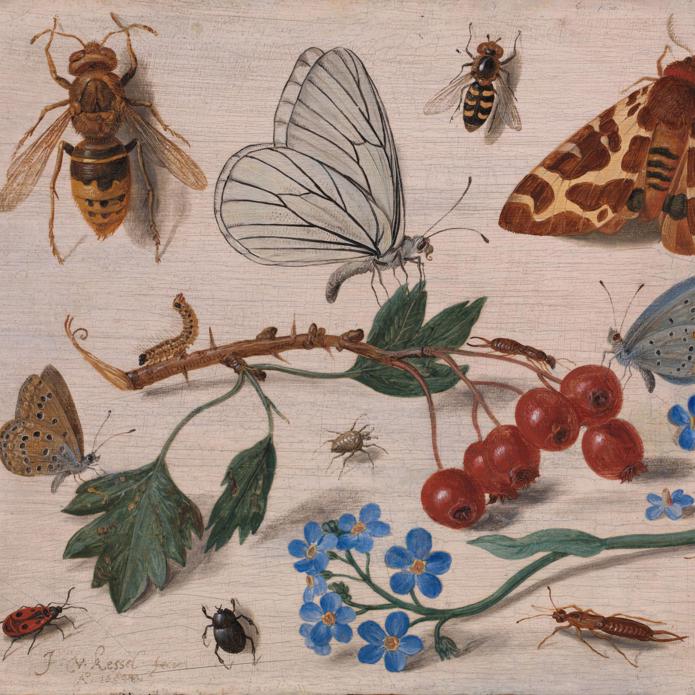Jan van Kessel the Elder, 'Insects with Creeping Thistle and Borage', 1654
About the work
Overview
Insects crawl on and around a spray of creeping thistle and borage flowers, all casually arranged to appear natural. But the creamy white surface is reminiscent of vellum, the prepared animal skin that was used for manuscripts and miniatures, highlighting the artificial nature of this composition.
The specimens are painted from different angles and viewpoints. The large tortoiseshell butterfly, crane fly and elephant hawk moth sitting on the leaves and stem of the creeping thistle are seen from the side, while most of the other insects, placed directly on the ground, are seen from above. This indicates that Jan van Kessel worked from a number of different sources, relying on illustrations in scientific books as well as actually studying insects himself . These inconsistencies, together with the painter’s signature and date on the surface, counter the illusion that these creatures and plants are three-dimensional.
Key facts
Details
- Full title
- Butterflies, Moths and Insects with Sprays of Creeping Thistle and Borage
- Artist
- Jan van Kessel the Elder
- Artist dates
- 1626 - 1679
- Part of the series
- Two Paintings of Insects and Small Flowers
- Date made
- 1654
- Medium and support
- Oil on wood
- Dimensions
- 11.8 × 14.7 cm
- Inscription summary
- Signed; Dated
- Acquisition credit
- Gift from the collection of Willem Baron van Dedem, 2017
- Inventory number
- NG6667
- Location
- Room 28
- Collection
- Main Collection
- Frame
- 17th-century Flemish Frame
Provenance
Additional information
This painting is included in a list of works with incomplete provenance from 1933–1945; for more information see Whereabouts of paintings 1933–1945.
Text extracted from the National Gallery’s Annual Report, ‘The National Gallery: Review of the Year, April 2017 – March 2018’.
Bibliography
-
2018National Gallery, The National Gallery: Review of the Year, April 2017 - March 2018, London 2018
About this record
If you know more about this work or have spotted an error, please contact us. Please note that exhibition histories are listed from 2009 onwards. Bibliographies may not be complete; more comprehensive information is available in the National Gallery Library.
Images
About the series: Two Paintings of Insects and Small Flowers
Overview
Cabinets of curiosities, or Kunstkammern – the early ancestors of the modern museum – flourished in Renaissance Europe. These encyclopaedic collections of natural objects and artworks were regarded as a microcosm of the world, and Jan van Kessel’s detailed and lifelike representations of insects, flowers and plants conformed to this style of collection and display.
The artist’s paintings were highly sought after by collectors during his lifetime. His tiny still-life paintings were often produced as pairs; some originally formed part of a series of plates that could decorate the front of the small drawers of the cabinet in which a collector kept his specimens.
Van Kessel belonged to a famous dynasty of painters, and his style and technique are similar to that of his grandfather, Jan Brueghel the Elder.



